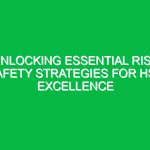Introduction
Risk measurement is a critical process in the Health, Safety, and Environment (HSE) sector, playing a pivotal role in safeguarding workers, the public, and the environment. By systematically assessing potential Hazards and their consequences, organizations can implement effective Safety Measures that not only protect lives but also enhance operational efficiency. This article delves into the intricacies of risk measurement in the HSE context, exploring its significance, methodologies, and Best Practices.
The relevance of risk measurement cannot be overstated. In an era where industries are held to stringent Safety Standards and environmental Regulations, a robust risk measurement strategy is indispensable. It allows organizations to anticipate potential Hazards, quantify risks, and make informed decisions that align with both legal requirements and ethical obligations. This proactive approach can prevent accidents, reduce liability, and foster a culture of Safety within organizations.
Key Aspects of Risk Measurement in HSE
Risk measurement encompasses several key components that are vital for effective management in the HSE domain. Understanding these components is essential for creating a comprehensive risk management framework.
1. Hazard Identification
The first step in any risk measurement process is hazard identification. This involves recognizing potential sources of harm that could affect employees, the public, or the environment. Hazards can be physical, chemical, biological, or ergonomic, and can arise from various sources such as equipment, processes, or workplace conditions.
For instance, in a manufacturing plant, a thorough inspection might reveal hazards like moving machinery, toxic chemicals, or slip hazards on the factory floor. Effective hazard identification often involves collaboration across departments, engaging employees in the process, and utilizing tools such as checklists, audits, and incident reports.
2. Risk Assessment
Once hazards are identified, the next step is to conduct a risk assessment. This process evaluates the likelihood of an incident occurring and the potential severity of its consequences. Risk assessment typically involves qualitative and quantitative approaches.
– **Qualitative assessment** involves subjective judgment about risks based on experience and knowledge.
– **Quantitative assessment** uses numerical data to calculate risk levels, often employing statistical methods and models.
For example, consider a construction site where scaffolding is used. A qualitative risk assessment might identify the risk of falls as significant, while a quantitative assessment could estimate the frequency of falls based on historical data, providing a clearer picture of potential outcomes.
3. Risk Control Measures
After assessing risks, organizations must implement Control Measures to mitigate them. This can be achieved through various strategies, commonly referred to as the hierarchy of controls:
- Elimination: Removing the hazard entirely from the workplace.
- Substitution: Replacing a hazardous material or process with a less dangerous one.
- Engineering controls: Isolating people from the hazard (e.g., using machine guards).
- Administrative controls: Changing work practices and policies to reduce exposure to hazards.
- Personal protective equipment (PPE): Providing Safety Gear to employees as the last line of defense.
Employing a combination of these measures is often necessary to create a safe working environment. For instance, a chemical manufacturing facility may eliminate the use of a particularly dangerous solvent (elimination), switch to a less toxic alternative (substitution), and implement engineering controls like ventilation systems.
4. Monitoring and Review
Risk measurement is not a one-time activity; it requires continuous monitoring and review. Conditions in a workplace can change, and new hazards may emerge, necessitating ongoing assessments. Regular audits, employee feedback, and incident analysis are essential for maintaining an effective risk management system.
For example, a hospital might regularly review its infection control protocols to adapt to new pathogens or changes in healthcare practices. This proactive approach ensures that risk management strategies remain relevant and effective.
Benefits of Effective Risk Measurement
Implementing robust risk measurement strategies in the HSE context yields numerous Benefits:
1. Enhanced Safety
The primary benefit of effective risk measurement is enhanced safety for employees and the public. By identifying and mitigating potential hazards, organizations can significantly reduce the likelihood of accidents and injuries.
2. Regulatory Compliance
Adhering to risk measurement practices helps organizations comply with national and international regulations. Regulatory bodies often require evidence of risk assessments and control measures, making comprehensive risk measurement essential for legal compliance.
3. Cost Savings
Investing in risk measurement can lead to significant cost savings over time. Fewer accidents mean lower insurance premiums, reduced liability costs, and less downtime due to injuries.
4. Improved Organizational Culture
A strong focus on risk measurement fosters a culture of safety within organizations. When employees see that their safety is prioritized, it boosts morale and encourages them to engage in Safe Practices actively.
Best Practices in Risk Measurement
To maximize the effectiveness of risk measurement strategies, organizations should consider the following Best Practices:
1. Engage Employees
Involve employees at all levels in the risk measurement process. Their insights and experiences are invaluable in identifying hazards and developing practical solutions.
2. Utilize Technology
Leverage technology to streamline risk measurement processes. Software solutions can help in data collection, risk assessment, and monitoring compliance, making the process more efficient.
3. Provide Training and Resources
Offer training programs that educate employees on risk measurement and management. Equip them with the knowledge and resources necessary to identify and report hazards effectively.
4. Foster Open Communication
Encourage open communication regarding safety concerns. Create an environment where employees feel comfortable reporting hazards without fear of reprisal.
Regulations and Standards
Understanding the regulatory framework governing risk measurement is crucial for organizations. Various regulations exist at local, national, and international levels that dictate safety standards and protocols.
For instance, in the United States, the Occupational Safety and Health Administration (OSHA) sets and enforces standards to ensure safe working environments. Compliance with these regulations often requires thorough risk assessments and documented safety Procedures. Similarly, the Environmental Protection Agency (EPA) mandates environmental risk assessments for certain industries, emphasizing the need for organizations to integrate environmental considerations into their risk measurement strategies.
Organizations must stay abreast of changes in regulations and standards to ensure ongoing compliance and adapt their risk measurement practices accordingly.
Conclusion
In summary, effective risk measurement is an essential aspect of health, safety, and environmental management. By systematically identifying hazards, assessing risks, implementing control measures, and continuously monitoring outcomes, organizations can create safer workplaces and protect the environment.
The importance of risk measurement extends beyond compliance; it fosters a culture of safety, drives cost savings, and enhances organizational reputation. As industries evolve and new challenges arise, the need for robust risk measurement strategies will only grow. Organizations must remain vigilant and proactive in their risk management efforts to ensure the safety and well-being of their employees and the communities they serve.
In closing, organizations are encouraged to reflect on their current risk measurement practices and consider areas for improvement. By prioritizing safety and environmental stewardship, they can contribute to a sustainable future for all.


